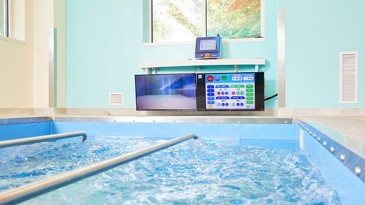
How Does Hydrotherapy Help in the Treatment of Neurologically Impaired Patients?
Aquatic therapy
How Does Hydrotherapy Help in the Treatment of Neurologically Impaired Patients?
My name is Sarah Wilkinson, I am a specialist neurological physiotherapist. I run a neurotherapy business which provides neurological rehabilitation to neurologically impaired patients in North Manchester, Bolton and Wigan areas.
In this article, I want to discuss the importance of hydrotherapy and the role it can play in the rehabilitation of a person with a neurological injury.
Aquatic (hydro) therapy is defined as:
“A physiotherapy programme utilising the properties of water, designed by a suitably qualified physiotherapist. The programme should be specific for an individual to maximise function, which can be physical, physiological or psychological. Treatments should be carried out by appropriately trained personnel, ideally in a purpose built, and heated pool” (HACP 2007- now ATACP)
How can hydrotherapy be used in neurological rehabilitation?
Many people with a neurological injury can suffer from pain, reduced range of movement, spasticity, reduced sensory/proprioceptive feedback, reduced mobility, fear of falling, balance problems and fatigue. Therapy in water can often increase a person’s confidence in their movement abilities and open a new world of experiencing movement without being in fear and pain. It can also be used to provide a time of relaxation in individuals with anxiety problems following neurological injury.
Hydrostatic pressure placed on the body when submerged in water allows for increased proprioceptive and kinaesthetic somatosensory input from muscles and joints effecting motor control (Ruoti et al, 1997; Becker et al, 2011; Kinser et al, 2011).
The unloading effect
The effects of buoyancy from the water can provide an unloading effect on individuals which is beneficial when treating a patient with pain or spasticity when weightbearing or walking, or in a patient with balance problems. The assistance of buoyancy can be influenced by increasing or decreasing the depth of water that the patient works in which can make therapy more or less challenging. Other uses of buoyancy are to help strengthen muscles, assist with joint movement and prolonged stretches. Turbulence in the water can be used to assist or resist movement, maintain or displace balance and to assist or resist walking.
Hydrotherapy is mainly used as another part of a person’s neurological rehabilitation treatment but can be used as a person’s only therapy input in some situations. Improvement in strength, range of movement, balance and gait all play a factor in a person’s quality of life and ability to maintain independence in a variety of activities. It can also be used in order to maintain levels of activity with a neurologically impaired patient who has a progressive condition, with the main aim of therapy being to maintain his or her current levels of active movement and function.
At Neurotherapy Worx we can offer your patient hydrotherapy sessions to suit their individual needs. An hydrotherapy programme can be formulated for the individual to complete with their support workers or one to one sessions can be provided with the patient.
Please email [email protected] or visit www.neurotherapyworx.co.uk if you require any further information or have an enquiry.


